12+ Sample Healthy Meal Plans
-
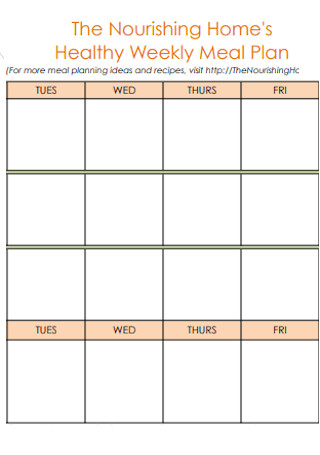
Healthy Weekly Meal Plan
download now -
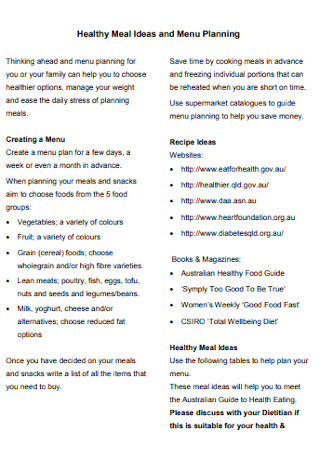
Healthy Meal Ideas Plan
download now -

Healthy Food Eating Plan
download now -
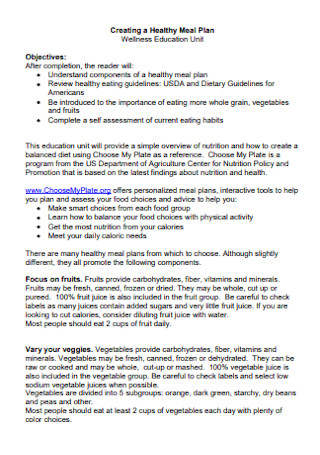
Healthy Meal Plan Format
download now -
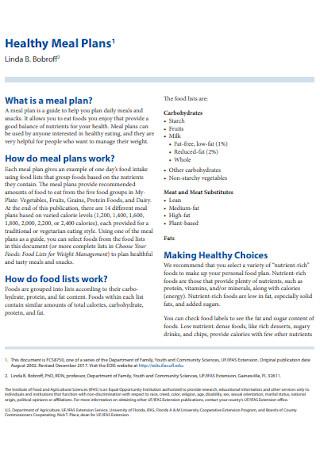
Sample Healthy Meal Plan
download now -
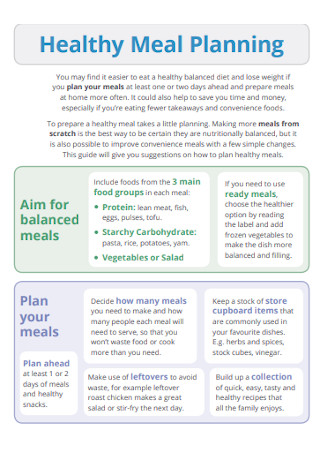
Basic Healthy Meal Plan
download now -

Healthy Meal Ideas and Menu Plan
download now -
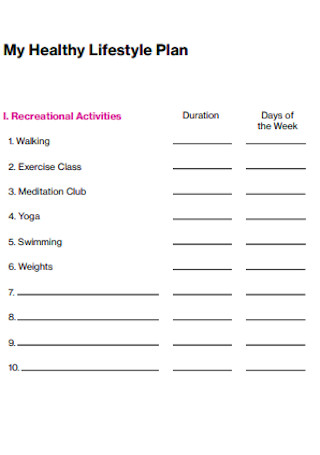
Healthy Lifestyle Meal Plan
download now -
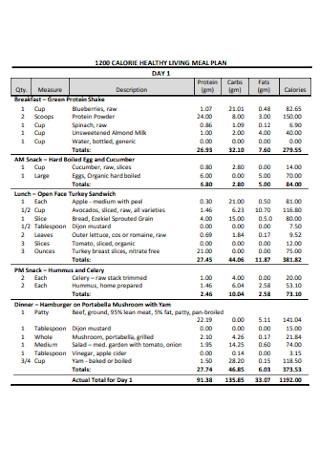
Healthy Living Meal Plan
download now -
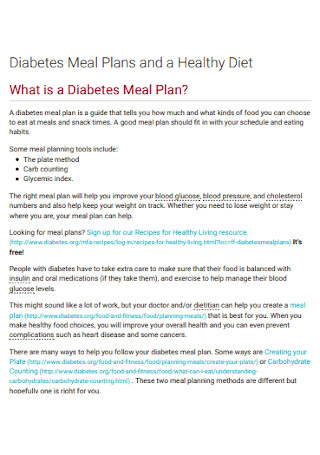
Healthy Diet Meal Plan
download now -
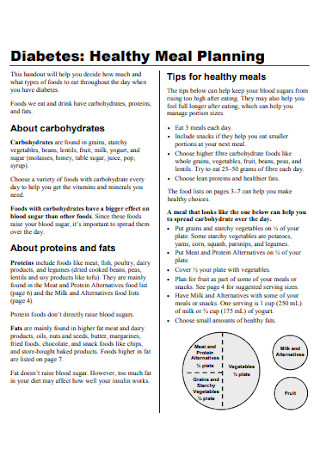
Healthy Meal Plan Template
download now -
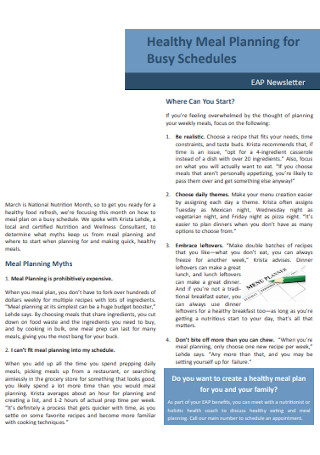
Healthy Meal Plan for Busy Schedules
download now -
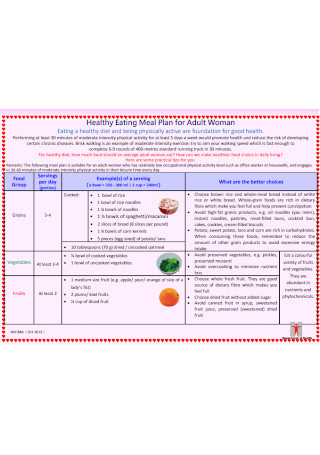
Healthy Eating Meal Plan for Adult
download now
FREE Healthy Meal Plan s to Download
12+ Sample Healthy Meal Plans
What Is a Healthy Meal Plan?
Benefits of a Healthy Meal
How to Create a Healthy Meal Plan
Food Examples of a Healthy Meal Plan
Who can prepare a meal plan?
Is it really necessary to replace all meats in a healthy meal plan?
How many calories are required per day?
How can one portion food sizes without a calorie counter or weighing scale?
What Is a Healthy Meal Plan?
A healthy meal plan is a guide that will help you plan and schedule your meals and snacks for the day, week, or month. Having a healthy meal plan allows you to eat the kind of food that you enjoy while at the same time provide you with balanced and nutritious food. A healthy eating plan lowers your risk of heart diseases and other lifestyle medical conditions.
With a healthy eating meal plan, you have the option to add an array of colors to your plate while ensuring that you get the nutrients that you need for energy and to achieve your health goals. Whether your dietary planner is filled with healthy meals on a budget or not, you should ensure that you stick to it and stay within your recommended calorie allowance.
Your healthy diet meal plan should emphasize foods such as vegetables, fruits, whole grain, and fat-free or low-fat dairy products. It must also include lean meats, poultry, fish, beans, and nuts as sources of protein, and limited saturated and trans fat, and sodium. And most importantly, your meal plan should also control for portion sizes.
Benefits of a Healthy Meal
A healthful diet is composed of nutrient-filled food from all major food groups. The medical community has long established that eating well and right has many health benefits for the body and being able to live comfortably and age well. Some of the benefits of a good and balanced diet include:
How to Create a Healthy Meal Plan
Anyone can have their own meal plans. It can be prepared by a nutritionist or you can create one on your own. Remember, there is no one-size-fits-all meal plan. You have to make choices and decide what works for you and what doesn’t while sticking to the required calorie and the right kind of food to include. Here are some steps you can take to start creating your own personal meal plan.
Step 2: Analyze the Article
Step 1: Review your Schedule
Figuring out your schedule is perhaps the most important first step you should take. You have to know when you usually eat when you have time to cook, and when you have the energy to cook and log them in your food diary. It is easier to make a meal plan that fits into your schedule than to enforce one that takes too much of your time or takes time away from things that you love doing too.
Try to find a few openings within your schedule, bloc them off, and set an appointment with yourself for preparing and cooking your meals. Make sure that you actually mark it in your planner or on your digital calendar to really get it done.
Step 2: Choose Your Recipe
There are so many recipes to choose from and so many cravings to attend to, so the question is, where do you begin? You start by considering your lifestyle factors to help you choose the kind of recipe that you may include in your meal plan.
Check your schedule–do you have the time to prepare a relaxing and delicious meal during weeknights or maybe a slow cooker recipe on days when you do your house chores? Perhaps you’re in a rush and a quick one-pot meal for fast and easy clean-up? Whatever it may be.
Check your pantry for ingredients. Do you have what you need stored away in your kitchen cupboards or in your refrigerator? You have the ingredients in your freezer that you can use? Take these into consideration when planning your recipe to reduce food waste and save on your budget too.
Step 3: Plug It Into Your Schedule
Now that you have your schedule and your recipe, combine the two. Plugin your recipe into the times that you dedicated specifically to cook your meals. To make cooking time more fun and enjoyable, set a food theme for your daily or weekly cooking schedule. Take a recipe from your list and plug it into the appropriate theme.
For instance, if you want a Meatless Monday or Taco Tuesday, you can prepare a vegetarian meal on Monday night and a taco and other Mexican dishes on Tuesdays.
Step 4: Make a Shopping List
At this point, people would say they’ve done too much. But nope! You revisited your pantry for a reason and you know what ingredients you will get. List down all the ingredients that you need for your recipes and identify how much you need for each ingredient by cross-checking it with what’s in your pantry and fridge.
Cross off all the ingredients that you already have and leave out those that you don’t have stocked or those that you need to add more and put on your priority list. Everything that’s left on your shopping list after cross-checking your pantry is your final grocery list.
Step 5: Go Grocery Shopping
Now it’s time to go shopping. Grocery shopping is therapeutic to some adults, but it does take time and sometimes, you become tempted to just order takeouts. But we live in modern times, and with the availability of different digital tools, it’s easier now to shop for your grocery needs online. It is essential for those who are running on a tight schedule–they can just order online and pick up the items at the store or have them delivered right at your doorstep. But you also have to make sure that you stick with your grocery list and not go over budget.
Step 6: Cook, Eat, Enjoy, and Repeat
Your meal plan is now complete! Stick with it and in time, it’ll be easier, plan more, save more and become healthier. Your healthy meal plan is the best investment you will have for your health and weight loss or weight gain journey. Just trust the process and enjoy it.
Food Examples of a Healthy Meal Plan
A healthful diet does not guarantee that it prevents diseases but it sure does give you the best defense against them so you will be able to live a long and healthy life. Here are some food log examples you may include in your planning for meal prep ideas for weight loss or whatever purpose you may have for a healthy meal plan
- Fruits and Vegetables
They contain high levels of antioxidants that are beneficial to your health. When getting vegetables, make sure you get a variety of colors so you can get all the different nutrients that you need for your body as well as maximize all health benefits.
- Whole Grains
This food group contains dietary fibers which are essential in lowering blood cholesterol levels and decreases the risk of hypertension and heart diseases. Having a high-fiber diet can also lower your risk of diabetes and other lifestyle diseases.
- Beans, Nuts, and Seeds
These are excellent sources of not only fibers but also protein and healthy fats. They have omega-3 fatty acids which can help lower risks of inflammation and heart disease. They are also rich in protein so it’s a good replacement for high-fat meat and a good snack alternative too.
Who can prepare a meal plan?
Meal plans can be used by anyone with different goals in mind. A dietary planner may be used by those who want to keep track of what food they eat and what they drink to have a better understanding of their eating habits. For some those who wish to manage their weight, a healthy weight loss plan or a gain weight meal plan are the ones that they should use.
Is it really necessary to replace all meats in a healthy meal plan?
No, it’s not necessary. But you do have to be careful as to what type of meat you consume and how much you eat. Lean meat is rich in protein, fish meat has omega-3 fatty acids, and chicken is considered white meat which is a good alternative to pork or beef.
How many calories are required per day?
Calorie intake per person varies and hugely depends on how much energy they require on a daily basis. It’s also dependent on a person’s gender, height, weight, level of physical activity, overall health, and goals. The estimated daily calorie intake for females with a sedentary lifestyle is between 1650 to 1900 while for males, it’s at 2150 to 2500 calories. For those with active lifestyles, between 2100 to 2350 for females aged 19 to 70 years old. Active males aged 19 to 70 years old need at 2650 to 3000 calories per day.
How can one portion food sizes without a calorie counter or weighing scale?
Use your hand–it’s the best portion size reference you can use if you don’t want to weigh your food to count calories. Your fist can be approximately one cup and the front of a closed fist is approximately half a cup, and the palm of your hand is an approximate serving size of your protein. You may also opt to control portions using your plate–half-filled with vegetables and salad, a quarter of good quality protein, and the remaining is composed of mixed carbohydrates and healthy fats.
A balanced lifestyle means enjoying the food that you eat in moderation. It doesn’t have to be a black and white categorization of good and bad. All foods are a source of nutrients, you just have to be careful about how much you eat and allow yourself to enjoy it with the help of a reliable healthy meal plan.
